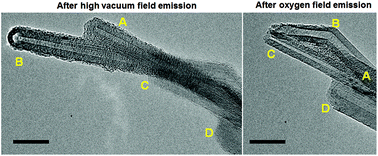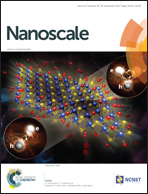The dissipation of field emitting carbon nanotubes in an oxygen environment as revealed by in situ transmission electron microscopy†
Abstract
In this work, we report the first direct experimental observations of carbon nanotubes (CNT) field emitting in an oxygen environment, using aberration-corrected environmental transmission electron microscopy in combination with an electrical biasing specimen holder under low-dose, field-free imaging conditions. Our studies show that while the CNTs remain stable during high vacuum field emission, they experience abrupt decreases in length, also termed “burn-back”, when field-emitting in an oxygen environment at around 30 Pa pressure. Furthermore, we perform correlative field-free and aberration-corrected, high-resolution transmission electron microscopy imaging to understand how the structure of the CNTs – particularly the opening of the nanotube caps – is influenced by its gas environment during field emission. This work provides significant insight into the mechanism of carbon nanotube behavior under non-ideal field emission conditions.


 Please wait while we load your content...
Please wait while we load your content...